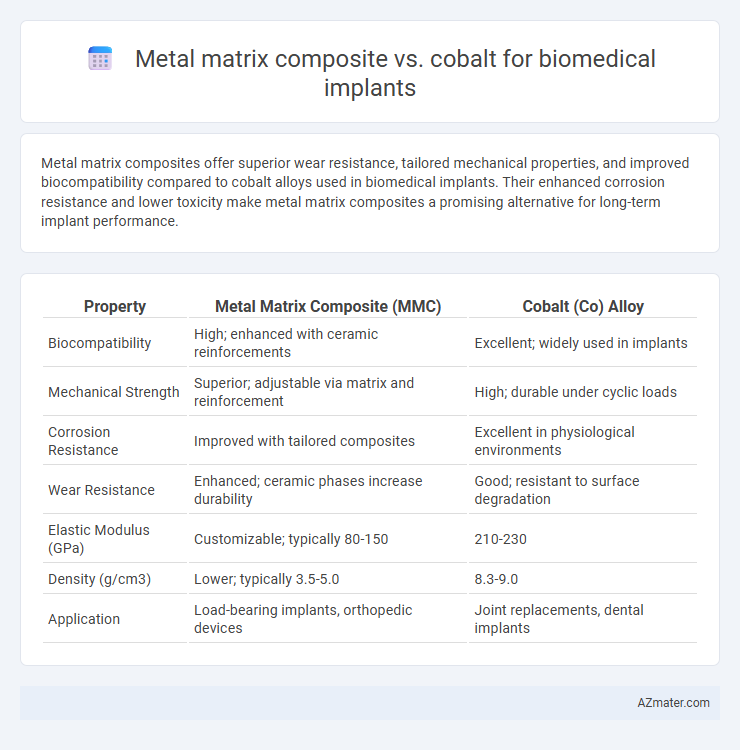Metal matrix composites offer superior wear resistance, tailored mechanical properties, and improved biocompatibility compared to cobalt alloys used in biomedical implants. Their enhanced corrosion resistance and lower toxicity make metal matrix composites a promising alternative for long-term implant performance.
Table of Comparison
| Property | Metal Matrix Composite (MMC) | Cobalt (Co) Alloy |
|---|---|---|
| Biocompatibility | High; enhanced with ceramic reinforcements | Excellent; widely used in implants |
| Mechanical Strength | Superior; adjustable via matrix and reinforcement | High; durable under cyclic loads |
| Corrosion Resistance | Improved with tailored composites | Excellent in physiological environments |
| Wear Resistance | Enhanced; ceramic phases increase durability | Good; resistant to surface degradation |
| Elastic Modulus (GPa) | Customizable; typically 80-150 | 210-230 |
| Density (g/cm3) | Lower; typically 3.5-5.0 | 8.3-9.0 |
| Application | Load-bearing implants, orthopedic devices | Joint replacements, dental implants |
Introduction to Biomaterials in Medical Implants
Metal matrix composites (MMCs) offer enhanced mechanical properties and wear resistance compared to traditional cobalt-based alloys, making them suitable for biomedical implants such as joint replacements and bone plates. MMCs can be engineered to possess superior biocompatibility, corrosion resistance, and tailored stiffness to match natural bone, reducing stress shielding and improving implant longevity. Cobalt-chromium alloys remain widely used for their strength and corrosion resistance, but emerging MMCs provide an optimized balance of performance, durability, and biological integration in medical applications.
Overview of Metal Matrix Composites
Metal matrix composites (MMCs) consist of metal alloys reinforced with ceramic or carbon-based fibers, providing enhanced mechanical strength, wear resistance, and biocompatibility compared to traditional cobalt-based implants. MMCs offer superior corrosion resistance and lower elastic modulus, reducing stress shielding effects in bone tissue regeneration. These properties make MMCs increasingly suitable for load-bearing biomedical implants, improving longevity and patient outcomes.
Understanding Cobalt-Based Alloys in Biomedical Applications
Cobalt-based alloys exhibit exceptional wear resistance, corrosion resistance, and biocompatibility, making them a preferred choice for load-bearing biomedical implants such as hip and knee replacements. These alloys, typically consisting of cobalt, chromium, and molybdenum, form a stable passive oxide layer that minimizes ion release and enhances longevity in physiological environments. Compared to metal matrix composites, cobalt alloys offer superior mechanical strength and fatigue resistance, essential for long-term implant performance in dynamic body conditions.
Mechanical Properties: Metal Matrix Composites vs. Cobalt
Metal matrix composites (MMCs) demonstrate superior mechanical properties compared to cobalt alloys, offering enhanced strength-to-weight ratios and improved wear resistance essential for biomedical implants. MMCs provide tailored stiffness and higher fatigue strength, reducing the risk of implant failure and stress shielding effects common with cobalt-based materials. The ability to customize reinforcement phases in MMCs allows precise control over hardness and elastic modulus, optimizing performance in load-bearing orthopedic applications.
Corrosion Resistance and Longevity
Metal matrix composites (MMCs) exhibit superior corrosion resistance compared to cobalt-based alloys, due to their tailored microstructure and protective ceramic reinforcements that enhance durability in physiological environments. Cobalt alloys, while biocompatible and strong, are more prone to ion release and surface degradation under body fluids, potentially impacting implant longevity. The enhanced corrosion resistance of MMCs contributes directly to prolonged implant lifespan and reduced risk of adverse biological reactions in biomedical applications.
Biocompatibility: Safety in Human Body
Metal matrix composites (MMCs) exhibit superior biocompatibility compared to cobalt-based alloys due to their enhanced corrosion resistance and reduced metal ion release, minimizing adverse reactions in the human body. MMCs, often reinforced with bioceramics like hydroxyapatite, promote better osseointegration and cellular response, improving implant longevity and safety. In contrast, cobalt implants may pose risks of metal hypersensitivity and cytotoxicity, challenging their long-term biocompatibility in biomedical applications.
Wear Resistance and Implant Durability
Metal matrix composites (MMCs) exhibit superior wear resistance compared to cobalt-based alloys, attributed to their reinforced microstructure with ceramic particles that enhance hardness and reduce friction in biomedical implants. The improved wear resistance of MMCs directly contributes to increased implant durability, significantly reducing the risk of wear debris-induced inflammation and implant failure in long-term applications. Cobalt alloys, while biocompatible and corrosion-resistant, generally offer lower resistance to abrasive wear, making MMCs a preferred choice for load-bearing orthopedic implants requiring extended lifespan.
Fabrication and Processing Techniques
Metal matrix composites (MMCs) for biomedical implants are fabricated using advanced techniques such as powder metallurgy, stir casting, and additive manufacturing, enabling tailored microstructures and enhanced mechanical properties. Cobalt-based alloys, typically processed through casting and forging, offer excellent wear resistance and corrosion resistance essential for implant longevity but have limited customization compared to MMCs. Processing MMCs allows incorporation of bioactive reinforcements like hydroxyapatite, improving osseointegration, whereas cobalt alloys rely primarily on their inherent alloying elements for biocompatibility and strength.
Cost and Economic Considerations
Metal matrix composites (MMCs) offer a cost-effective alternative to cobalt-based alloys for biomedical implants due to lower raw material expenses and enhanced mechanical properties that reduce long-term device failure rates. The production costs of MMCs are often mitigated by their improved wear resistance and corrosion performance, potentially decreasing the need for revision surgeries and overall healthcare expenses. Cobalt alloys, despite their proven biocompatibility, generally involve higher material and processing costs, impacting the economic feasibility for large-scale implant manufacturing.
Future Trends and Innovations in Implant Materials
Metal matrix composites (MMCs) for biomedical implants are advancing through enhanced biocompatibility and tailored mechanical properties, surpassing traditional cobalt-based alloys in corrosion resistance and wear performance. Innovations in nanotechnology and surface engineering are enabling MMCs to mimic bone elasticity more closely, promoting better osseointegration and reducing implant failure rates. Future trends emphasize hybrid composites integrating bioactive ceramics and smart materials to improve implant longevity and patient outcomes beyond current cobalt implant capabilities.

Infographic: Metal matrix composite vs Cobalt for Biomedical implant
 azmater.com
azmater.com